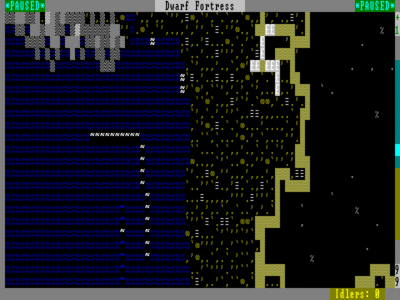- v50 information can now be added to pages in the main namespace. v0.47 information can still be found in the DF2014 namespace. See here for more details on the new versioning policy.
- Use this page to report any issues related to the migration.
Difference between revisions of "40d:Ocean"
Wolfman2000 (talk | contribs) (Use "official" template.) |
|||
| Line 1: | Line 1: | ||
| − | {{av}} | + | {{av}}{{Quality|Fine}} |
An '''ocean''' is an immense volume of {{L|Water|saltwater}}. There are generally two or three oceans on every generated map. They come in three varieties, based on temperature, which affects the sea life found there: {{L|Biome#Arctic|Arctic}}, {{L|Temperate}} and {{L|Tropical}}. It is not possible to found a fort solely in an oceanic {{L|biome}}; some land is needed. | An '''ocean''' is an immense volume of {{L|Water|saltwater}}. There are generally two or three oceans on every generated map. They come in three varieties, based on temperature, which affects the sea life found there: {{L|Biome#Arctic|Arctic}}, {{L|Temperate}} and {{L|Tropical}}. It is not possible to found a fort solely in an oceanic {{L|biome}}; some land is needed. | ||
Revision as of 19:06, 5 May 2010
| This article is about an older version of DF. |
An ocean is an immense volume of Template:L. There are generally two or three oceans on every generated map. They come in three varieties, based on temperature, which affects the sea life found there: Template:L, Template:L and Template:L. It is not possible to found a fort solely in an oceanic Template:L; some land is needed.
Geography
Oceans tend to have a heavy effect on the surrounding geography of the generated world. Template:Les can often be found around the perimeter of the ocean, and this tends to be easiest place to find them. Template:Les and Template:Ls also tend to form around oceanic coastlines, especially near Template:Ls. The land surrounding oceans also tends to have a high water table, resulting in Template:Ls close to the surface.
Survival
Ocean areas will always contain salt water, even in pools that are quite some distance away. They are also rather notorious for containing Template:Ls of multiple layers. The fishing will usually be good near an ocean, and there won't be as many Template:L or similar fish to deal with.
Ocean biomes contain only salt water, which will require Template:L before dwarfs will drink it. If this is not done, it will be impossible to give your dwarves water when they are injured, quite possibly leading to their death. Your military will have a high turn over rate while Template:L.
Life next to an ocean
Despite the warnings that the fortress selection screen displays, oceanside Template:Ls can be quite habitable - provided they are chosen well.

Oceans have a multitude of benefits: they're generally sparsely populated, and usually have an abundance of Template:L Template:L. Ocean Template:L are usually abundant and a good source of Template:L, though some sea Template:L can be dangerous, particularly in Template:L areas. Some oceans have Template:L beaches, a good resource for Template:Lmaking. Oceans also provide a few unique geographic features, including stacks of Template:L and ocean waves - which crash against the beach to produce Template:L (Although this mist does not seem to generate Template:L). The erosion caused by waves also tends to leave numerous exposed mineral veins and Template:L deposits at sea level, and some minerals like Template:L form deposits in alluvial areas.
Despite these benefits, oceanic shorelines provide some challenges, and can be difficult starting areas. It is important to check for some variation in topography when choosing an ocean location, as the ground is almost always water-laden one tile down from sea-level. Even if slightly hilly terrain is found, there is no guarantee that Template:L will still be accessible. Template:Ls tend to make good Template:L additions, as they tend to have more varied terrain than marshes and swamps. When picking a forest it is important that the treeline extends at least two tiles away from the shoreline on the Local Map, otherwise you may potentially only have stacks of useless driftwood and no actual Template:L and Template:L.
Draining the ocean
Not a good idea. It is possible to reduce the water level near the shore to fordable depths by draining it into an aquifer layer or using an array of Template:L. However, doing this will cause even a high-end computer to grind to a halt as the movement of each tile of water is calculated, and the water at the edge will refill faster than it can be drained. This can also easily turn into a fatal Template:L scenario, and the sheer quantity of rushing water tends to drag dwarves into the drain holes.
It is however satisfying to watch the Template:L corpses pile up in the shallow water.
If you access the ocean from a lower level (such as by channeling away two z-levels at once, or by building a ramp up into it, from a site with drainage to 8 squares of aquifer), the entire region that is connected at this level will immediately drain away the water above it. (If a ridge blocks the lower level of ocean, the water on the next layer up will only drain out from the far side once a channel is dug from the partially filled top level to connect the two regions) In one test the top level of ocean did not seem to be replenished once drained, but the edge of the second layer down was permanently held at 1/7 while cascading to the next level down.
Worlds | |
|---|---|
Badlands · Desert · Flatland · Forest · Glacier · Lake · Marsh · Mountain · Murky pool · Ocean · River · Rocky wasteland · Sand desert · Swamp · Tundra |